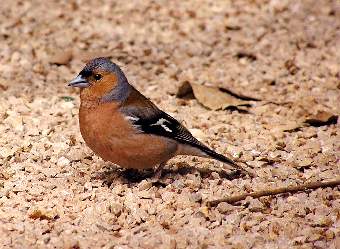|
|
|
The Chaffinch (Fringilla coelebs, as named
by Linnaeus in 1758) is a small graceful bird who is quite common in many
parts of Europe. As well as Europe, its habitat includes North Africa
western Asia and the Canary Islands, where they live in each case in forests,
gardens and parks. In addition some live in mountains up to approximately
1,500 meters high.
|

Picture of male Chaffinch in a park
|
Chaffinch Description
Their body length is around 14 to 18 centimeters,
and they weigh a delicate 20 grammes approximately. The male
has a bluish gray upper head and neck. The lower parts are brownish-red.
The female is characterized by a more greenish brown colour. Both have
two remarkable white wing bars and a greenish rump.
They have a short, thick and conic beak.
By using this small but strong beak they can easily release seeds from
hard shells. As well as seeds of all kinds, the food of the Chaffinch
also consists of berries, fruits and insects. Some courageous Chaffinches
can be fed in presence of humans with fine breadcrumbs or seeds.
Chaffinches run on the ground with a rhythmical
head-nodding. Their flight is an up and down wavelike undulating motion.
|
Breeding and song of the Chaffinch
In the spring the male starts loud singing to mark
its breeding area, and can be heard to sing his song from February to September.
The song itself lasts a maximum 5 seconds, and can easily be repeated 10
times in a minute. A Chaffinch generally sings 2 or 3 different
songs in several versions, and in different areas of the world, regional
dialects of different calls can be heard. The song is learned from
the father or other chaffinches, but in places where other finch species,
for example canaries, are also found the chaffinch can copy the call of
a canary or other finch as part of its repertoire.
The thick-walled Chaffinch's nest is carefully
constructed from includes roots, fibers, mosses, and lichens. Inside it
is equipped with hair and individual feathers. The nest is built usually
at a height of two to ten meters on bushes or high in the trees in a forked
branch, and is well camouflaged by the moss and lichen construction materials.
The female Chaffinch breeds once or twice during
a year and lays four to six light brown or bluish-white eggs, which can
be colored quite differently from nest to nest. They always however
have red to dark-brown marks. If she senses danger the female ducks herself
deep down into the base of the nest.
The incubation period amounts to thirteen to fourteen
days. After hatching the chicks are fed with insects and larvae by both
parents. About fourteen days after they first hatched the young birds leave
the nest.
The coelebs part of the Chaffinch's latin species'
name (Fringilla coelebs), means, in Latin, single person (caelebs).
It was chosen by Carl von Linnaeus (1707-1778) because, in Sweden, only
the females and the young birds migrate in winter while the males remain
in their home area, leading a celibate existence until the Springtime.
Blue Chaffinch and Other species
of the Fringilla Genus
The Chaffinch is one of three species which comprise
the genus Fringilla, this genus in turn being part of the larger Fringillidae
family of finches. In the Islands of the Atlantic a different species
of Fringilla is more often found, this being the Blue
Chaffinch (Fringilla teydea). Although this bird
looks relatively similar to the Chaffinch of Europe, it is slightly larger
with bluish plumage on the male. The female is a brownish grey.
Overall the Blue chaffinch is considered to have a a less "bright" appearance
than the Chaffinch of Europe. The third and final species of the
Fringilla genus is the Bramble
Finch or Brambling (Fringilla montifringilla)
|
|
|





